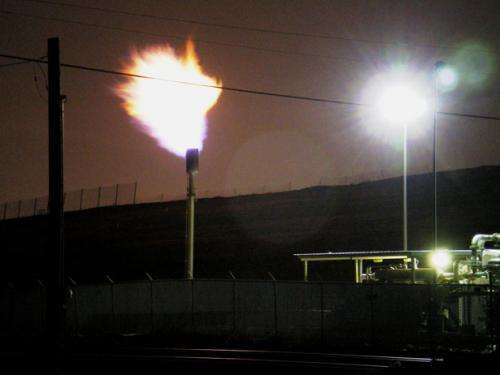July 11, 2014 report
Satellite data shows livestock emitted more methane than oil and gas industry in 2004

Analysis of data received from a satellite in 2004 has shown that at least during that year, livestock in the U.S. emitted more methane into the atmosphere than did the oil and gas industry. In their article published in Journal of Geophysical Research: Atmospheres, a team of researchers from Harvard University, California Institute of Technology and the University of California studying the data note that such emissions were far higher than was reported by the U.S. Environmental Protection Agency (EPA).
Most everyone knows by now about the problems with carbon dioxide in the atmosphere—most agree that it's causing global warming. But there is another greenhouse gas that is also of concern: methane. Though it doesn't stay in the atmosphere as long, it's better at blanketing the planet, causing warming. For that reason, scientists and governments attempt to monitor how much is being emitted into the atmosphere due to manmade actions so that plans for reducing it can be put into place. The prime culprits are the oil and gas industry, and livestock (though likely a significant source, amounts of methane emitted by human flatulence is not counted.) In this new effort, the researchers have found that the actual amounts being emitted by both sources in the U.S. don't match what the government has been reporting.
Back in 2004, the ENVISAT satellite with a special sensor aboard took measurements of gasses in the atmosphere across the planet. The researchers used that data to create a map of methane emissions all across the U.S., focusing most specifically on areas where high volumes of methane emissions could be seen. They compared their map with other maps created by other teams using data collected from airplanes and found agreement in areas covered by the planes. In comparing what they found with data supplied by the EPA, however, the researchers found differences in the amounts reported for both livestock and the oil and gas industry.
Specifically, the researchers found satellite data showed livestock emitted 13 million tons of methane over the summer in 2004 (the EPA reported 9.7 million tons). They found the satellite data also showed that the combined emissions of the oil and gas industry amounted to 7 million tons (the EPA reported 9.9 million tons).
Unfortunately the sensor on the satellite was unable to show methane amounts after 2004, thus more data is not available. That will change soon however as a new satellite with sophisticated atmospheric gas monitoring sensors aboard is set to launch next year.
More information: Wecht, K. J., D. J. Jacob, C. Frankenberg, Z. Jiang, and D. R. Blake (2014) "Mapping of North American methane emissions with high spatial resolution by inversion of SCIAMACHY satellite data," J. Geophys. Res. Atmos., 119, DOI: 10.1002/2014JD021551
Journal information: Journal of Geophysical Research - Atmospheres
© 2014 Phys.org
















